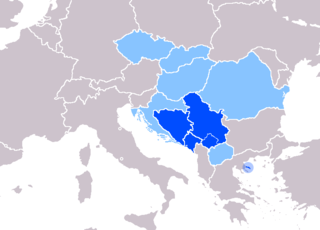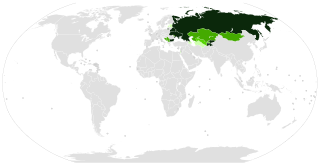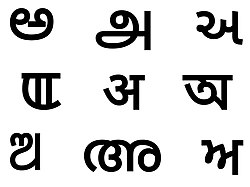
The Cyrillic script, Slavonic script or simply Slavic script is a writing system used for various languages across Eurasia. It is the designated national script in various Slavic, Turkic, Mongolic, Uralic, Caucasian and Iranic-speaking countries in Southeastern Europe, Eastern Europe, the Caucasus, Central Asia, North Asia, and East Asia, and used by many other minority languages.
Transliteration is a type of conversion of a text from one script to another that involves swapping letters in predictable ways, such as Greek ⟨α⟩ → ⟨a⟩, Cyrillic ⟨д⟩ → ⟨d⟩, Greek ⟨χ⟩ → the digraph ⟨ch⟩, Armenian ⟨ն⟩ → ⟨n⟩ or Latin ⟨æ⟩ → ⟨ae⟩.

Various Mongolian writing systems have been devised for the Mongolian language over the centuries, and from a variety of scripts. The oldest and native script, called simply the Mongolian script, has been the predominant script during most of Mongolian history, and is still in active use today in the Inner Mongolia region of China and has de facto use in Mongolia.

Serbian is the standardized variety of the Serbo-Croatian language mainly used by Serbs. It is the official and national language of Serbia, one of the three official languages of Bosnia and Herzegovina and co-official in Montenegro and Kosovo. It is a recognized minority language in Croatia, North Macedonia, Romania, Hungary, Slovakia, and the Czech Republic.

In linguistics, romanization is the conversion of text from a different writing system to the Roman (Latin) script, or a system for doing so. Methods of romanization include transliteration, for representing written text, and transcription, for representing the spoken word, and combinations of both. Transcription methods can be subdivided into phonemic transcription, which records the phonemes or units of semantic meaning in speech, and more strict phonetic transcription, which records speech sounds with precision.
An official language is a language having certain rights to be used in defined situations. These rights can be created in written form or by historic usage.

Kha, Khe, Chi, Ha, occasionally Xe is a letter of the Cyrillic script. It looks the same as the Latin letter X, in both uppercase and lowercase, both roman and italic forms, and was derived from the Greek letter Chi, which also bears a resemblance to both the Latin X and Kha.

In linguistics, mutual intelligibility is a relationship between languages or dialects in which speakers of different but related varieties can readily understand each other without prior familiarity or special effort. It is sometimes used as an important criterion for distinguishing languages from dialects, although sociolinguistic factors are often also used.
A national language is a language that has some connection—de facto or de jure—with a nation. The term is applied quite differently in various contexts. One or more languages spoken as first languages in the territory of a country may be referred to informally or designated in legislation as national languages of the country. National languages are mentioned in over 150 world constitutions.
BGN/PCGN romanization are the systems for romanization and Roman-script spelling conventions adopted by the United States Board on Geographic Names (BGN) and the Permanent Committee on Geographical Names for British Official Use (PCGN).

The Hindi–Urdu controversy arose in 19th century colonial India out of the debate over whether Modern Standard Hindi or Standard Urdu should be chosen as a national language.

The Arabic script is the writing system used for Arabic and several other languages of Asia and Africa. It is the second-most widely used alphabetic writing system in the world, the second-most widely used writing system in the world by number of countries using it, and the third-most by number of users.

The Serbian Cyrillic alphabet is a variation of the Cyrillic script used to write the Serbian language, updated in 1818 by the Serbian philologist and linguist Vuk Karadžić. It is one of the two alphabets used to write modern standard Serbian, the other being Gaj's Latin alphabet.

In sociolinguistics, digraphia refers to the use of more than one writing system for the same language. Synchronic digraphia is the coexistence of two or more writing systems for the same language, while diachronic digraphia is the replacement of one writing system by another for a particular language.

Numerous Cyrillic alphabets are based on the Cyrillic script. The early Cyrillic alphabet was developed in the 9th century AD and replaced the earlier Glagolitic script developed by the theologians Cyril and Methodius. It is the basis of alphabets used in various languages, past and present, Slavic origin, and non-Slavic languages influenced by Russian. As of 2011, around 252 million people in Eurasia use it as the official alphabet for their national languages. About half of them are in Russia. Cyrillic is one of the most-used writing systems in the world. The creator is Saint Clement of Ohrid from the Preslav literary school in the First Bulgarian Empire.

Latinisation or latinization was a campaign in the Soviet Union to adopt the Latin script during the 1920s and 1930s. Latinisation aimed to replace Cyrillic and traditional writing systems for all languages of the Soviet Union with Latin or Latin-based systems, or introduce them for languages that did not have a writing system. Latinisation began to slow in the Soviet Union during the 1930s and a Cyrillisation campaign was launched instead. Latinization had effectively ended by the 1940s. Most of these Latin alphabets are defunct and several contain multiple letters that do not have Unicode support as of 2023.

The romanization or Latinization of Serbian is the representation of the Serbian language using Latin letters. Serbian is written in two alphabets, Serbian Cyrillic, a variation of the Cyrillic alphabet, and Gaj's Latin, or latinica, a variation of the Latin alphabet. The Serbian language is an example of digraphia.

The spread of the Latin script has a long history, from its archaic beginnings in Latium to its rise as the dominant writing system in modernity. The ancestors of Latin letters are found in the Phoenician, Greek, and Etruscan alphabets. As the Roman Empire expanded in classical antiquity, the Latin script and language spread along with its conquests, and remained in use in Italy, Iberia, and Western Europe after the Western Roman Empire's disappearance. During the early and high Middle Ages, the script was spread by Christian missionaries and rulers, replacing the indigenous writing systems of Central Europe, Northern Europe, and the British Isles.














